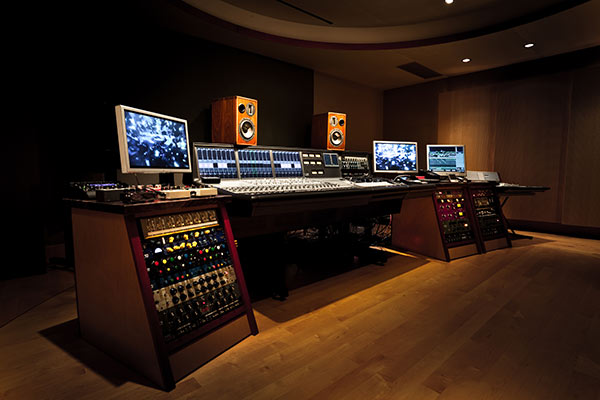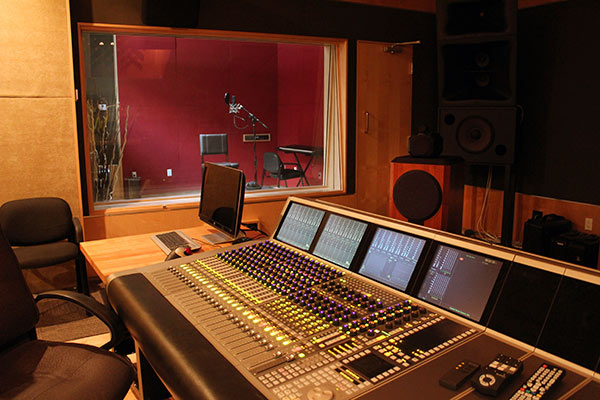Room Acoustics: Building Levels
Designing and building a professional audio studio is a complex and expensive undertaking. And not just every architect and contractor can be counted on to know the critical factors involved in doing it right. There are 5 studios in my building. Yesterday, I shared the plans showing my main mixing room, which is the largest one. I hired an experienced architect and a construction manager to take care of the day-to-day details but a handyman that came with the building did most of the actual construction. Skilled, experienced carpenters, electricians, and finish people don’t come cheap. The difference between the dollars that Jack of Pirate Audio charged the tenant in the middle of the building to build his beautiful room and what Jamie charged me was quite substantial…may 4-5 times as much per hour. My room cost several hundred thousand dollars and the Astound Studio (that showed up on the cover of Mix magazine) was well over one million!
Figure 1 – The Astound Sound Studio – this was the professional photo used for the cover of Mix magazine.
I saved a lot of money and we had to rework some things but at the end of the day, the room sounds fabulous. It’s the little things that will get you…like avoiding screws that go through multiple layers of dry wall and sound board or having an experienced finish carpenter take care of the double solid core doors that must close with an airtight whoosh.
The expensive room even has a custom “studio door” that seals out every external noise. It should because it cost over $8000. It’s the only thing that the tenant insisted he be able to take with him when his term is up (I’m sure I will be purchasing the door…at a discount). Everything else stays…the expensive floating floor (they poured a layer of concrete on a form that is elevated 3 inches from the building slab on rubber squares), the designer fabrics that were stretched and steamed on the walls, the light cans that were encased in their own isolation boxes, and the elaborate 40 foot HVAC routing that guarantees that no wind noise is created as air flows in and out of the room. Everything is separated by rubber seals. No nails, no screws, or electrical conduits were allowed to punch through the multiple layers in the space. A hole is a hole is a hole…and sound gets through even the smallest openings.
My studio doesn’t have its own concrete floor. The floors joists are isolated from the outside world using dense rubber runners. But I did construct a room within a room to keep outside disturbances from compromising the interior space. Another less expensive room was build for much less money. I closed up a window and had Jamie build two new interior walls (non parallel walls) isolated from the existing room with rubber all around.
Figure 2 – AIX Studios looking into the iso booth.
And there’s a new tenant coming in to a space that was formerly my office. I spent part of Sunday removing the suspended acoustic ceiling. Tomorrow, Jamie and I will start building a hard ceiling comprised of 10-inch joists. They will be isolated from the walls with rubber. The ceiling will be a layer of sound board and then a layer of drywall. There will be boxes placed around each of the light cans, lots of insulation, and then a layer of sound board topped with 3/4″ plywood on the top. The HVAC will be run around the perimeter in 16″ ducting to isolate the air noise. We’ll add a solid core door with some weather striping and the new tenant will be able to make loud music inside.
The walls are painted drywall and they are parallel. The plan calls for fabric covered sound panels on one end and heavy theatrical drapes on the other. The reflections will be minimized.




Off Topic, I know, sorry but I just had to say something.
3. Charge the same as regular res – Establish a single price for the CD spec audio and the high-res version. Give people a “brainless” reason to go with better.
Unfortunately things are getting worse and worse at HDTracks,
Led Zep – In Through The Out Door 24/96 14 Tracks + unreleased “rough” tracks. OH BOY. Only $29.98
Led Zep – Presence 24/96 13 Tracks + 5 unreleased (crap) tracks Only $27.98
All from 40 year old analog tapes.
I could go on but what for, there are plenty more where those examples came from. IMHO they’re shooting themselfs in the foot and REALLY giving HDA a worse name than it already has.
I can find early release pre-loudness wars CD’s for under $5
Except for special releases like JT’s Before This World I”m done with HDTracks, I’m not the brightest light on the tree but I’m no fool either. Now they’re making me mad and they deserve a few flame posts around the audiophile web sites.
Very sad
HDtracks doesn’t control the underlying price of the albums they sell. The labels establish the prices and then HDtracks adds their usual 30%. I wrote to the Chesky’s to ask about the details. I’ll let you know what I find out.
OK Understood, thanks.
Only thing then is that it’s just a different bad guy. As we all know thanks to you and others the provenance issue is starting to become widespread knowledge. I read Rob Sabin’s article “Hi-Res and the Art of Provenance” in this months Sound & Vision, also Ken Pohlmanns June Signals article (Saving Hi-Res Audio where he takes a light hearted swing at Pono quoting David Pogue and more. The writings are a bit on the PC side but they are telling the truth about the general HDA promotion world. Sabin says “Hi-res audio has a dirty little secret”. Ha Ha
So as the truths on HDA become more well known even outside the “hardcore audiophile” world, those in power continue to raise prices to ever more ridiculous heights re-mastered 40+ year old tapes..
Unfortunately for you and the other honest studios, I smell a meltdown starting in the HD industry.
I haven’t seen the Rob Sabin article but I written to him…with no reply.
Dear Mark,
What is the noise level (silence noise) at your main studio? I got the minimum of 25dB at my home theater room. Is that good or acceptable?
I honestly don’t know what the noise level is of my room…it’s very quite. If you’re measuring only 25 dB SPL in your home theater that’s very good.